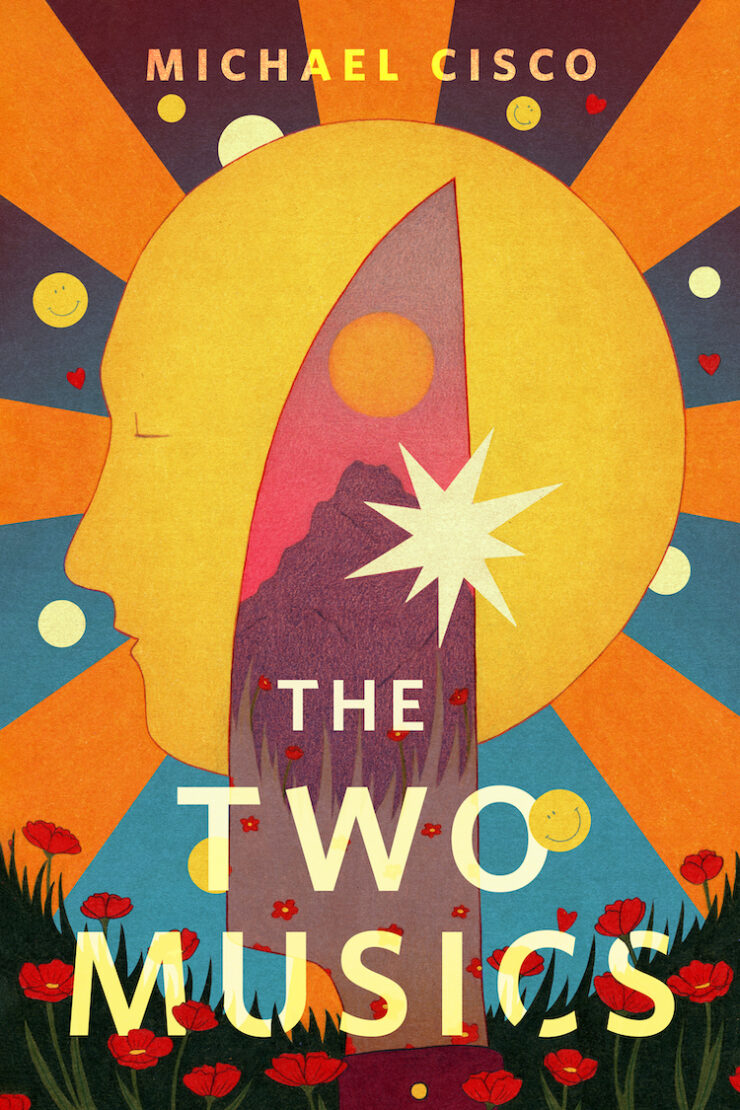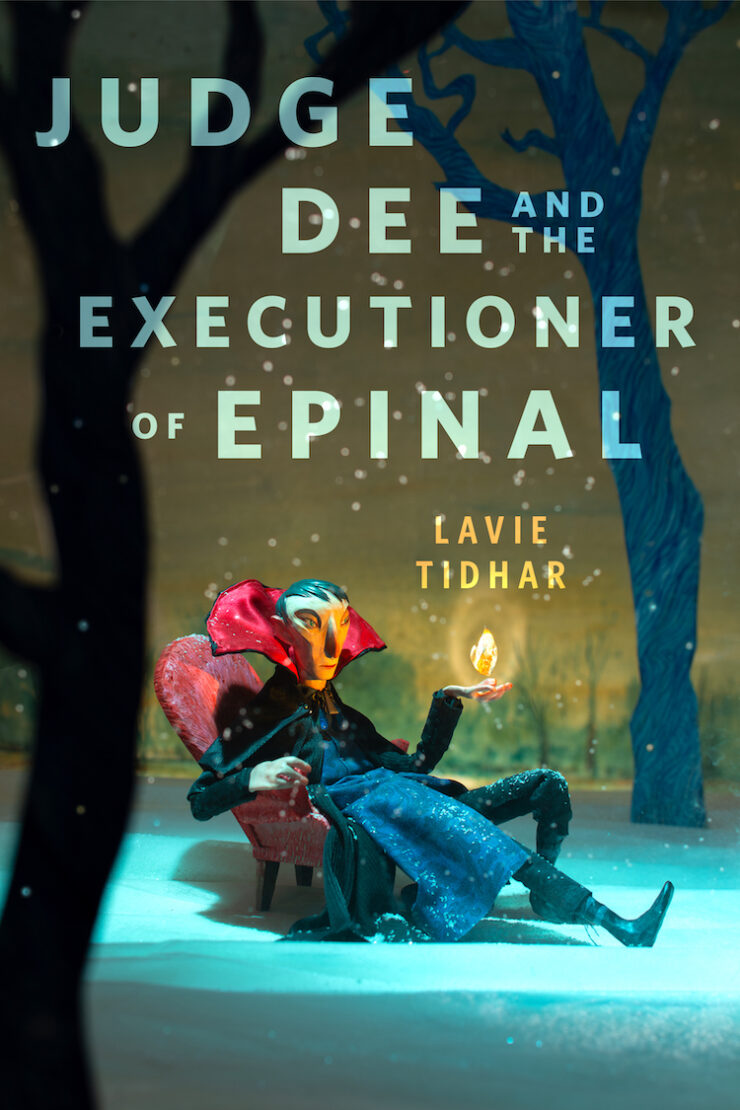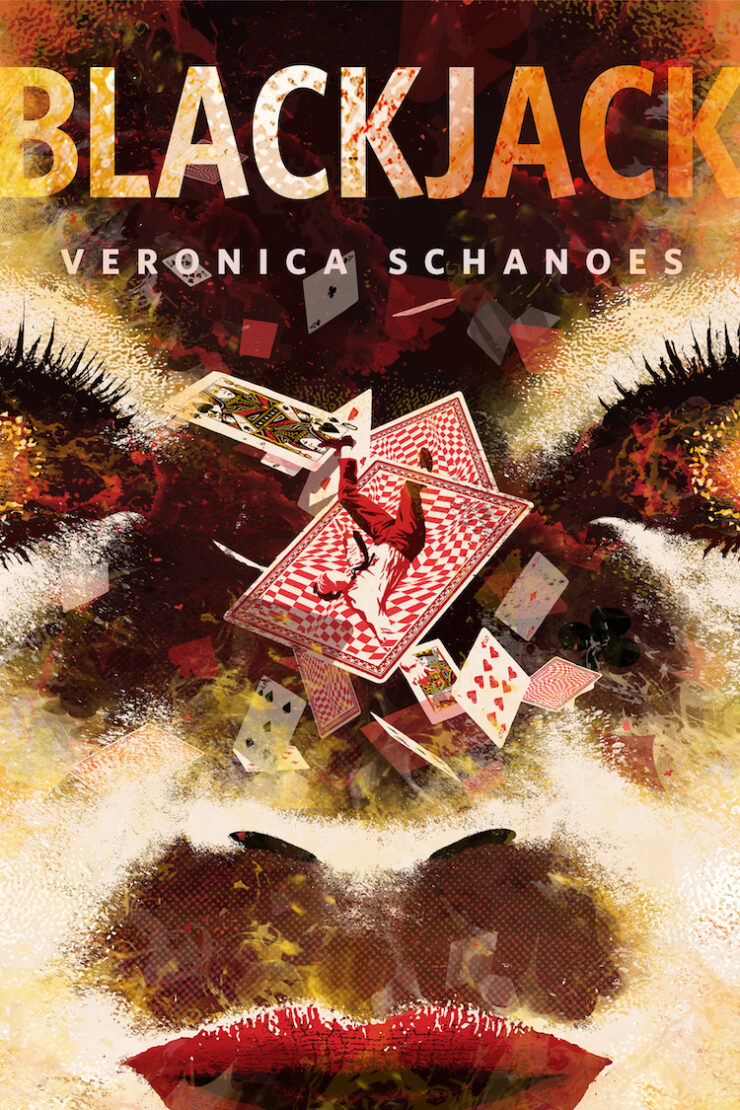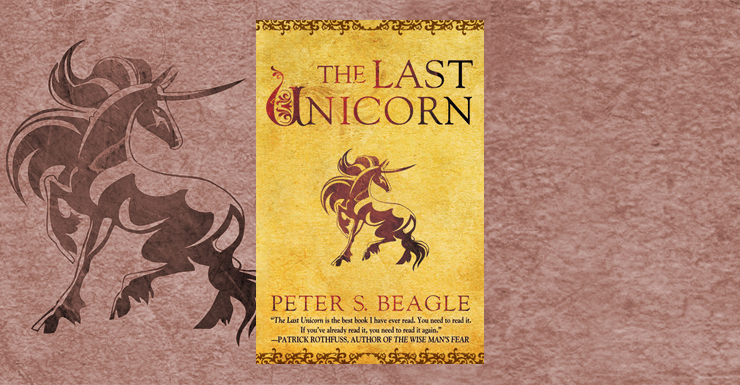The Last Unicorn was the book that taught me how to love.
And it didn’t have anything to do with the doomed Prince Lír and the titular unicorn—although an immortal creature learning about regret certainly taught me other lessons. I first learned what true love was from Molly Grue and Schmendrick the magician.
In the novel—and bear with me if the story is already part of your bones—there is only one unicorn living free in the world. She realizes that she is the last and sets out to find her compatriots. Along the way she picks up Schmendrick (a magician who is attempting, and failing, to reach his full power) and Molly Grue (the fierce, but soft-hearted, former maid/cook for a group of Robin Hood wannabes). Molly and Schmendrick bristle at each other when they meet, but they put their bickering aside for a common goal: to help the unicorn. Their help isn’t always effective… Honestly, it’s often bumbling. Schmendrick turns the unicorn into a human woman so that they can gain access to the castle where the unicorns are kept (magic, do what you will!), and once there, the prince falls for her in short order. Molly takes over cooking in the castle’s kitchens while Schmendrick’s time is consumed entertaining a sociopathic king. The quest pauses for a while, and they live a life of tedium, biding their time.
As part of the backdrop to the unicorn’s and the prince’s grand romance, Molly and Schmendrick gradually begin to care for each other. Theirs is not a romance of dramatic, sweeping gestures. They partake in the tasks of a mundane day-to-day existence—one must work, one must make food and sweep floors, one must expend emotional energy listening to a prince complain about how killing a manticore did not win the unicorn-lady’s heart. But it is because of these tasks that Schmendrick and Molly form their bond. Schmendrick does not serenade her (though he does serenade the crotchety old unicorn-kidnapping king). Molly does not primp or prepare candlelit specialties for Schmendrick: she’s busy keeping the inhabitants of an entire castle fed and watered.
Molly cooks for the guards, befriends the castle cat, acts as therapist to both the erstwhile unicorn and the bumbling prince, and searches the stone walls for the secret path to save the unicorns from eternal imprisonment. Molly Grue: she gets stuff done.
The unicorn and the prince trip through a whirlwind romantic arc of heroic acts, poetry, and sacrifice, only to be separated in the end by the reversal of a spell and a change of species. They experience regret and longing for an imagined relationship that never came to fruition. Molly and Schmendrick, on the other hand, remain together long beyond the completion of the quest. These two relationships are perfect examples of the romantic entanglements we see modelled most often in western storytelling: the intense-but-never-meant-to-last grand romance vs. the durable and long-lived partnership. The former certainly has its appeal, and perhaps that is why the unicorn and Prince Lír storyline is so compelling. They are both beings born from deep loneliness and solitude, and in each other they find solace. I would argue, however, that they never truly see each other. Lír tries to win a unicorn by slaughtering mythical beasts, but she only feels pity for the dead creatures. For her part, the unicorn (as a woman) wants nothing more than for Lír to be selfish and place their love before the more difficult choice: to accept her as human and not demand that she complete her quest of saving the other unicorns. If only he had given up the identity of hero and grasped her hand, they may have been able to stay together—or perhaps they would have been slaughtered by the Red Bull. To this day, I still cry each time I get to the line:
The prince had not yet noticed her offered hand, but in a moment he would turn and see, and touch her for the first time. He will never know what she has given him, but neither will she. The Red Bull lowered his head and charged.
At the end of their quest, the unicorn and prince retreat back into solitude, accompanied now by regret and the memory of a shining moment that couldn’t last.
Molly and Schmendrick, on the other hand, last well beyond the final page. As the story unfolds, they first build understanding, then trust, then compassion, and finally true love. Their love is not a pinnacle of achievement, but a verb, an ongoing action: loving and patiently puzzling a life together out of small and necessary tasks. In the end, they see each other as strong and capable of meeting the hardships and adventures that life presents; they walk down the path together, singing a folk song, ready to meet what comes, and trusting one another to be equal to whatever tasks the future holds.
This is the model of love The Last Unicorn taught me. This example of a robust relationship, built through adventure and shared experience, is not unique to The Last Unicorn, however—many fantasy narratives share this strength: showing how lasting, realistic love can be built even if the events of the story are anything but ordinary or familiar in scope.
Fantasy stories, charged as they are with the otherworldly, have power—one not dissimilar to stand-up comedy, in a sense. By disarming a reader’s suspension of disbelief (with magic rather than with laughter) a writer can relay universal truths into parts of a psyche inaccessible without the magic of story.
Tristran and Yvaine, of Neil Gaiman’s Stardust, also meet under bristly circumstances. Yet, it is through eventually uniting their efforts toward common goals—mainly centered on saving Yvaine from the witches who pursue her—that they tackle the obstacles the world beyond the wall has to offer. In time, they realize they share a love built on their common experience. Their relationship is a foil to Tristran’s attempted courtship of his hometown’s beauty, Victoria. To win her favor, he promises diamonds. He promises gold. He promises a polar bear’s head. He even promises to bring her back a fallen star. Fortunately, that fallen star turns out to be Yvaine, and together she and Tristran build a love not predicated on material objects, but instead on what they can achieve together.
I’m going to pause my examples here, for a moment, to ponder etymology. In English, we cram a lot into a four-letter word: love. We include physical attraction, lust, and affection—and of course affection can be maternal, familial, friendly, or romantic in nature. Perhaps for my brief purposes it would be useful to call a spade a spade (or perhaps a heart a heart?) and use the crunchy specificity that English has granted us. I am defining love as a verb. I love those I care about. I show it by doing things for them with no expectation of reciprocation. Love expressed in action builds mutual trust. It is how people know they have support, someone who will not fall when they falter or make a misstep. It is being grateful to share the joys and hardship of a life with another soul.
In Philip Pullman’s world of daemons and innocence, Lyra and Will meet in The Subtle Knife and join forces out of necessity. Adults are hunting them down for daring to encounter “dust”—a physical manifestation of self-awareness and sexuality. They become equals in their powers: Lyra with her golden compass that tells the truth and Will with his knife that can cut between worlds. Together, they defy the adults, defy the church, defy a megalomaniacal angel. They separate their bodies from the manifestations of their souls—their daemons—so that they can enter hell, face the harpies of the underworld, and cut a hole in the other side of the land of the dead so that souls can escape suffering and experience freedom and re-birth. They achieve all this—and more, it’s a hell of a trilogy—by relying on each other. In the end they are reunited with their daemons and are able to experience the highest possible level of trust with one another: laying their hands on another’s daemon, another person’s soul, becoming one entity made of two. They are able to reach this place through growth and effort; their adventures and travails have made them true equals.
In another quest involving young people finding their way into adulthood, Maggie Stiefvater’s Raven Cycle explores several key relationships, including that between Ronan Lynch and Adam Parrish. This is a romance that takes time to build—over two books and years of previous friendship and competition—and in the third book of the series, Blue Lily, Lily Blue, the two boys’ love for each other fully develops. This compassionate, open love is contrasts with the relationship Ronan experiences in the second book—one of drug-fuelled intimacy, excessive gifts, crashing cars—a complex, troubled affair that ends with the other boy’s suicide. In the third book, Ronan enters into a much different relationship with Adam. They build it tentatively—it is already a friendship, but they begin to share trauma, and bond over what they want to change in the world. In contrast to the excessive gift giving that characterized Ronan’s time with Kavinsky, their exchanged gifts are tiny necessities, like bottles of lotion to heal the cracked skin of Adam’s hands. Together, they are able to build a body of evidence to blackmail an antagonist who wishes to capture Ronan. Stiefvater weaves together the intensity of teenage rebellion, grief over the death of loved ones, parental abuse, finding one’s sexuality, and compounds all of these feelings with supernatural conflicts encountered while ghost hunting with psychics. As the characters conquer otherworldly threats, we also see these boys grapple with the teenage realities of jealousy and trauma. They are able to grow by conquering both supernatural and more worldly problems together.
Buy the Book
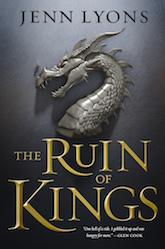

The Ruin of Kings
Fantasy can also offer readers an escape from the prejudices that are so ingrained in our culture. In Audrey Coulthurst’s Of Fire and Stars, religion and prejudice have pushed magic users to the edge of society, but it is a world where same-sex unions are not discriminated against. Two princesses, Denna and Mare, from allied kingdoms fall for each other, but their relationship is prohibited—not because they are both women, but because Denna is betrothed to Mare’s brother. The princesses team up to investigate the assassination of a member of the court, since no one else seems to be taking their concerns seriously. They are shackled by family pressures, attitudes about duty, and promises made to their superiors and to their communities. Their story explores the tensions that arise when the upholding of honor must be done at the expense of love. It is through breaking rules together, trying to unearth who is behind the growing unrest in the kingdom, and also through the joys of horse riding and song, that the girls find their heart’s counterpoint in one another and their love of mutual adventure.
Fantasy taught me that love is not a first look, nor a grand gesture. Love is built from a hundred tiny sacrifices toward a common goal. Love is reaching the end of a trial or adventure and celebrating not just one’s own achievements, but what two were able to accomplish together.
This is an old lesson, but one that deserves to be revisited and reiterated, and deserves to be mirrored in the stories of our own lives. In life, as in The Last Unicorn, “there are no happy endings because nothing ends”—but in fantasy stories, readers can uncover a path to joy in our numbered days. In the continuous river of a life, it is the moments we share with our loved ones, the ones we partake in as equals, and the things we conquer together that build true love.
Jaclyn Adomeit writes historical fiction, speculative fiction, and comics. In her spare time, she befriends stray cats and daylights as an environmental engineer. She can be found on Facebook, Twitter, and her website.


